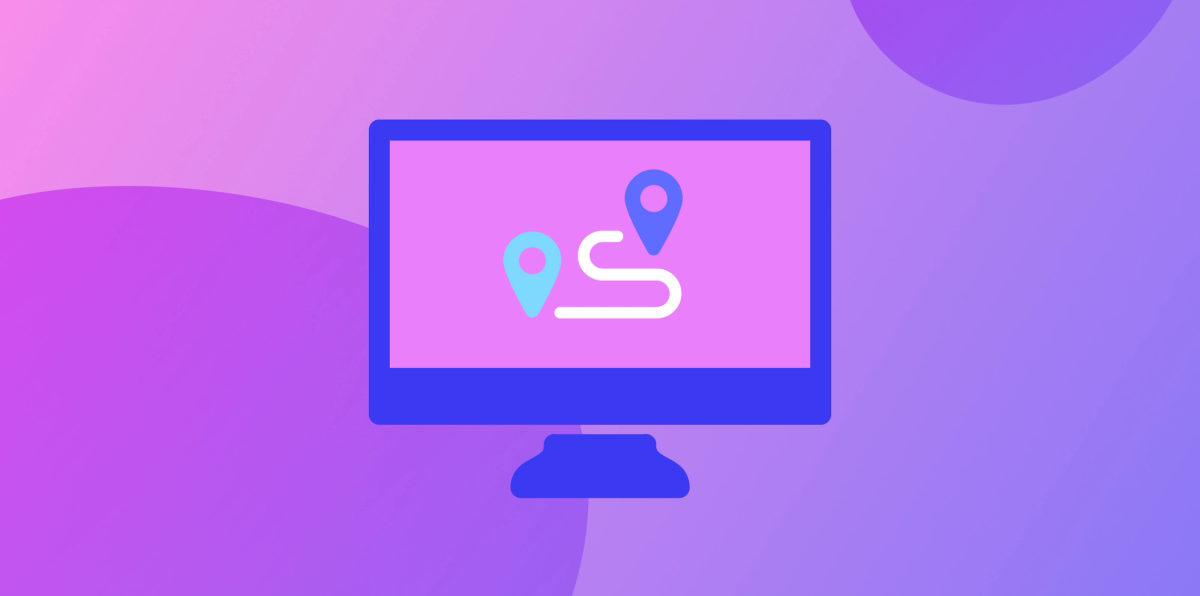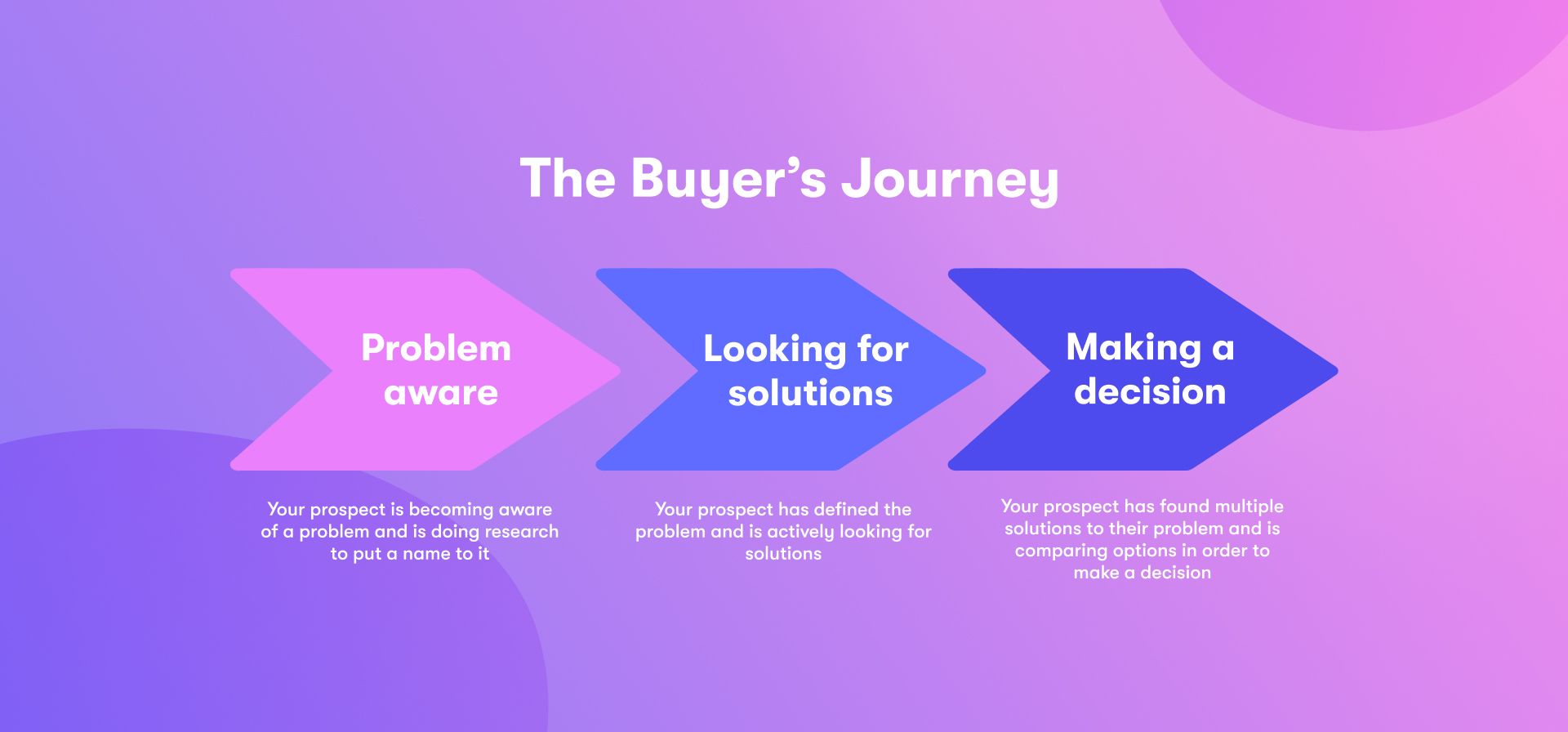How to Use the Buyer’s Journey in Your Marketing Content

Becoming a part of the buyer's journey
These days, consumers have all the power. We have a world of information at our fingertips, and reaching out to brands to find the perfect product or service takes all of two seconds to do. People are more informed than ever before and usually come into a sales environment with a pretty good idea of what they want.
In order to drive a successful marketing campaign and attract an audience of potential buyers, you have to switch your perspective a bit. It's less about leaning into that old-school "salesy" approach and more about being helpful by delivering content people can use.
Don't worry! It's not as complex as it sounds. The key to success in today's market is to understand the buyer's journey.
No, we're not talking about some Greek epic here–the buyer's journey is the stages of research consumers do before buying a product or service. With this blog, we'll follow the trail of sprinkles to give you a lowdown of the various stages of the buying process. We'll also give you some crucial tips on sweetening the deal along the way.
Ready to be helm the pen and create a journey's end that works in your favor? Read on!
What is the buyer's journey?
The buyer's journey is a simple process that every consumer goes through before deciding to make a purchase. There's a good chance that you've wandered this path yourself without realizing it.
Most people don’t wake up and decide, "Hey, I think I'm going to buy a swanky new vacuum cleaner today!"
Sure, they might make an impulse purchase when they see a fantastic deal. However, the crumbs were already there. This imaginary vacuum buyer likely already made their way through the buyer's journey and knew what they wanted.
Think about the last significant purchase you made. How did you realize you needed it in the first place? More importantly, what brought you to decide on the type of product or brand you chose?
The answer to those questions is in your buyer's journey!
Why should you care?
If you want to have the most impactful content plan possible, you'll want to pay attention to each stage of the buying process.
Remember what we said earlier about being helpful instead of overtly sales-focused? Squeezing yourself into the buyer's journey will help you do just that. Understanding the stages of the buying process is seeing through the eyes of your potential customers. You see things from your intended audience's perspective, giving you further insight into creating content that sticks.
Ultimately, you can use the buyer's journey to nudge potential shoppers your way while still being super helpful to their needs.
Many companies focus on the so-called "Sales Funnel." The buyer's process is pretty similar. But funnels are boring, so we're going to look at it as a tasty ice cream cone:

The top of the cone is the sprinkles. They represent your customer's spark of interest. As they make their way through the ice cream, first speculating on potential solutions, then comparing different flavors and deciding on their favorite one, they get closer and closer to the chocolatey end of the cone. The final treat at the end is their purchase.
You can use the buyer’s journey to your advantage by producing content that appeals to the customer at every stage they’re in, answering their questions as they move down the sales funnel. By taking the buyer's journey into consideration, you’re not only able to guide prospective customers to the purchase stage, but you’re also able to gain their trust and make your site a source of information.
The stages of the buyer’s journey
Let's break down the buyer's journey stages. This concept is pretty widespread, and you might read about different versions of the buying process or sales funnel. Consumers are complex, and many will go through several steps before deciding.
However, the easiest way to look at this process is to separate it into three distinct stages. They include the awareness stage, the consideration stage, and the decision stage.

1. Awareness
The first stage of the buyer's journey is awareness. As the name would imply, this is when a consumer first realizes they have a problem and starts investigating potential solutions.
That might sound dramatic, but the problem doesn't have to be serious. It just needs to be a solvable problem.
For our buyer's journey example, we'll follow Amanda. Amanda has some struggles that we can all relate to right now: collaborating with her teammates remotely.
She's leading a big advertising campaign for her company and is working with several teams to create usable creative assets. Because she's not working in-office, she's doing everything through emails. Amanda finds out pretty early on that email collaborating just isn't cutting it.
Things are getting lost in the shuffle, and revisions are becoming a nightmare. Even leaving notes and moving drafts along is a hassle.
Amanda is in the awareness stage because she realizes that she needs to solve a problem. So what does she do? Like most, she takes to Google and starts doing some research.
She wants to learn more about how she can fix this issue. Her search terms will be generally vague, and there's no interest in a specific product or brand just yet. Right now, it's about learning and discovering options.
Typically, the first stage includes lots of research. She may read:
- Educational blogs
- eBooks
- Whitepapers on the topic
- Guides
- Infographics
- Official reports
To capture Amanda early on in the buying process, you can create content that caters to what she's looking to find. She needs to put a name to her problem so that she can research potential solutions. Meet her needs and provide valuable content that addresses her specific pain point, and she may come back to your product as a customer.
2. Consideration
The consideration stage is all about finding the solution to the earlier problem. At this point, the problem is clear. Consumers can communicate specifics of the issue and want to start actively looking for solutions that address it.
Let's go back to our buyer's journey example. Amanda knows why completing this project is such a nightmare: The team isn't using a collaborative platform built for remote work. They're winging it without using readily available technology. Instead of having one centralized platform for all team members to work from, she's using segmented ways of communication. That's a massive headache that doesn't need to exist!
Amanda has a clear scope of the problem and now wants to fix it. Her research will continue. However, it's more focused on specific products and services that meet her needs. For example, she might consume content like:
- Comparison guides
- How-to videos
- Technical blogs
- Webinars
- Product-focused podcasts
Now is a great time to provide resources that let your audience know how your product or service fits into their needs. You can influence perception and highlight how your brand can help.
3. Decision
Finally, we make it to the decision stage! Think of this stage as the bottom of the ice cream cone. Potential customers are on the cusp of reaching that sweet center. They know what solution they want. However, they need to figure out what brand is best.
Back to our buyer's journey example, Amanda is actively comparing products and brands. She knows what she wants, but she must find a vendor who can meet it. Here is where you can make a tremendous impact.
Consumers want to know that your brand has the expertise to fulfill their needs to a tee. Not only that, but they're exploring price points, experience, and other finer details. They want to know you have a good track record and understand their struggles and desires. If you've already followed the buyer's journey up to this point, you should have all the insight you need to leave a lasting impression.
Your turn!
The buyer's journey can get more in-depth, but the three stages are the main gist you need to know. Use the stages of the buying process to your advantage.
When you get on the ground floor with your audience, you can learn tons of helpful information. It's about putting yourself in their shoes and delivering the content they need most. Give it a try! You'll be surprised by how much of a difference crafting your content around the buyer's journey can make!
